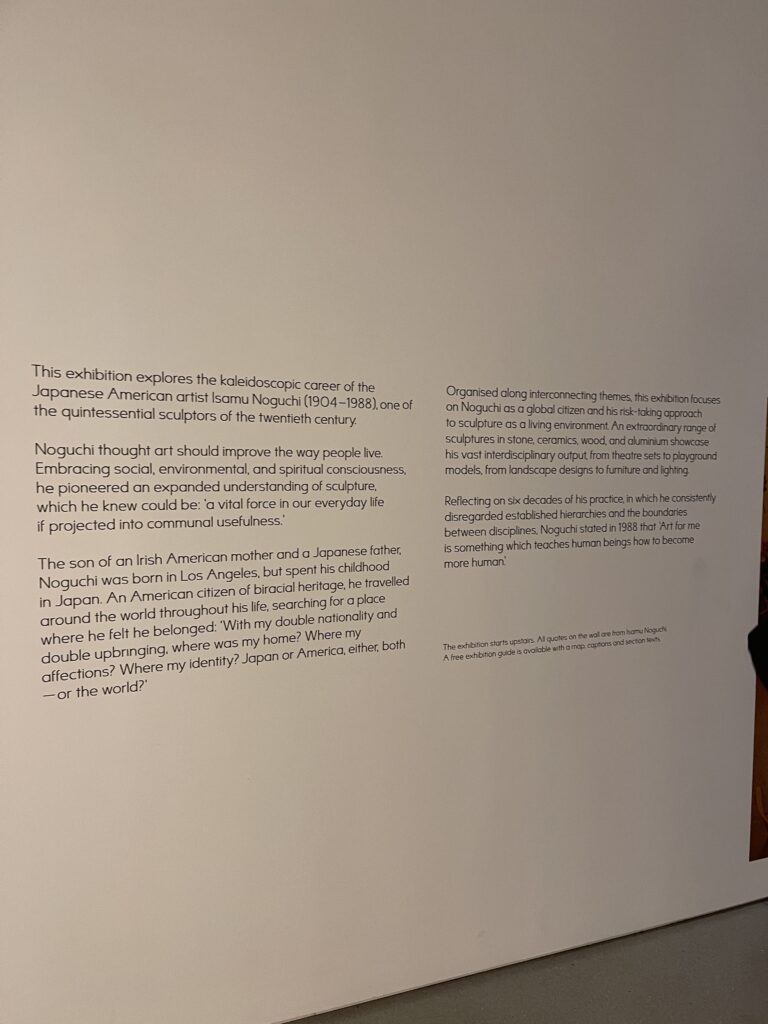|
Getting your Trinity Audio player ready...
|
As we entered Noguchi’s exhibition on the third floor of the Barbican, London, we were instantly met with an introduction to the exhibition and Isamu Noguchi. From the outset, the exhibition shows Isamu was a very complex man with a sense that he had difficulty belonging.
An artistic polymath that travelled across many borders, he confronted these deep emotions and feelings using powerful sculptural expressions in an array of fields showcased during the six decades of his practice. In 1938, Noguchi stated that “Art for me is something which teaches human being how to become more human.”

To truly understand the complexity of Isamu’s work you must first know more about the man himself.
Isamu Noguchi Ethnicity
Isamu Noguchi, often dubbed ‘the Picasso of sculpting’, was born in Los Angeles in 1904 to famous Japanese poet Yonejiro Noguchi and American editor Léonie Gilmour.
A complicated upbringing
Isamu’s parents had a complicated past. They met in Los Angeles in 1901, where Léonie agreed to become Yonejiro’s English teacher/editor. Assisted by Léonie, Yonejiro published his first novel ‘The American Diary of a Japanese Girl’ in 1902. By the end of 1903, the couple were married in secret. However, Yonejiro maintained romantic affairs, including with writer Charles Warren Stoddard and one of their friends Ethel Armes, an American journalist based in Washington D.C. Ethel and Yonejiro would later be engaged.
By the time Léonie realised she was pregnant, her marriage with Yonejiro was waning. To avoid despair, she decided to have her child in Los Angeles with her mother nearby. A boy was born November 18, 1904.
When the birth was publicised in the Los Angeles Herald and news reached Ethel Armes, she broke off her engagement to Yonejiro. It is important to add that according to the Noguchi Exhibition Catalogue, Isamu was nameless for the first two years of his life.
In 1907, after several months of convincing and despite the increasing anti-Japanese sentiment swept along by the first Russo-Japanese war, Léonie joined Yonejiro in Tokyo. When she arrived, she discovered Yonejiro had married a Japanese woman, Takeda Matsuda, without her prior knowledge. Around the time of Takeda’s second pregnancy in 1909, Léonie separated from Yonejiro.
Léonie continued living in Japan as a teacher in Yokohama. In 1912, Léonie gave birth to a half Japanese daughter, Ailes Gilmour. It has been speculated that the father was one of her students. Ailes would go on to be a pioneer of the American Modern Dance movement in the 1930s.
While living in Yokohama with his mother, Isamu attended the Yokohama International School, where children of American expatriates studied, to make him become ‘American’. Here, Isamu was met with adversity as he was seen by his classmates as ‘Japanese’. Commentators suggest these interactions were formative: “These early confrontations and questions of identity, belonging and discrimination would accompany him for the next eight decades of his life.”
Travelling Alone
In the summer of 1918, aged 13, Isamu enrolled at a boarding school in Rolling Prairie, Indiana, under the name Sam Gilmour. His education was disrupted by the outbreak of the First World War when his school was taken over for military use. Consequently, he lived with the school headmaster Dr. Edward Rumley in La Porte. Léonie and Ailes joined Isamu in America in 1920, and he graduated high school in 1922.

